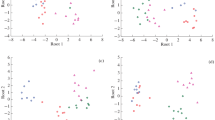Abstract
Microanalysis methods were used to determine the effect of bilateral carotid occlusion on net levels of energy metabolites in discrete cellular regions of the hippocampus and dentate gyrus of the Mongolian gerbil. Glucose, glycogen, ATP and phosphocreatine levels were not decreased after one minute of bilateral occlusion. Three minutes of ischemia, however, produced a dramatic fall in net levels with no further decrease observed at fifteen minutes. Re-establishment of blood flow for five minutes after a fifteen minute ischemic episode resulted in replenishment of metabolites to pre-ischemic levels. Glucose was increased two to three times in sham-operated animals as compared to control (non-operated) animals. The increase was the result of the Na-pentobarbital anesthetic employed. The present data indicate that regions of the hippocampus and dentate gyrus respond in a uniform manner to bilateral occlusion of the carotid arteries. Further, most cells maintained enough viability to resume production of high-energy phosphate and carbohydrate metabolites.
Similar content being viewed by others
References
Bubis, J. J., Fujimoto, T., Ito, U., Mrsulja, B. J., Spatz, M. andKlatzo, I. 1976. Experimental cerebral ischemia in Mongolian gerbils. V. Ultrastructural changes in H3 section of hippocampus. Acta Neuropathol. 36(3):285–294.
Dixon, F. D., andMeyer, A. 1936. Respiration of brain. Biochem. J. 30:1577–1582.
Ferrendelli, J. A., Gay, M. H., Sedgwick, W. G., andChang, M. M. 1972. Quick freezing of the murine CNS: Comparison of regional cooling rates and metabolite levels when using liquid nitrogen or freon-12. J. Neurochem. 19:979–987.
Folbergrova, J., Lowry, O. H., andPassonneau, J. V. 1970. Changes in metabolites of the energy reserves in individual layers of mouse cerebral cortex and subjacent white matter during ischaemia and anaesthesia. J. Neurochem. 17:1155–1162.
Gatfield, P. D., Lowry, O. H., Schulz, D. W., andPassonneau, J. V. 1966. Regional energy reserves in mouse brain and changes with ischaemia and anaesthesia. J. Neurochem. 13:185–195.
Kahn, K. 1972. The natural course of experimental cerebral infarction in the gerbil. Neurology 22:510–515.
Kobayashi, M., Lust, W. D., andPassonneau, W. D. 1977. Concentrations of energy metabolites and cyclic nucleotides during and after bilateral ischemia in the gerbil cortex. J. Neurochem. 29:53–59.
Levine, S., andPayan, H. 1966. Effects of ischemia and other procedures on the brain and retina of the gerbil. Exp. Neurol. 16:255–262.
Levy, D. E., andDuffy, T. E. 1975. Effects of ischemia on energy metabolism in the gerbil cerebral cortex. J. Neurochem. 24:1287–1289.
Levy, D. E., andDuffy, T. E. 1977. Cerebral energy metabolism during transient ischemia and recovery in the gerbil. J. Neurochem. 28:63–70.
Lowry, O. H., andPassonneau, J. V. 1972. A Flexible System of Enzymatic Analysis. Academic Press, New York.
McCandless, D. W., Feussner, G. K., Lust, W. D., andPassonneau, J. V. 1979. Metabolite levels in brain following experimental seizures: the effects of maximal electroshock and phenytoin in cerebellar layers. J. Neurochem. 32:743–753.
McCandless, D. W., Feussner, G. K., Lust, W. D., andPassonneau, J. V. 1979. Sparing of metabolic stress in Purkinje cells after maximal electroshock. Proc. Natl. Acad. Sci. USA. 76(3):1482–1484.
Mrsulja, B. B., Mrsulja, B. J., Itok, U., Walker, Jr., J. T., Spatz, M. andKlatzo, I. 1975. Experimental cerebral ischemia in Mongolian gerbils, II. Changes in carbohydrates. Acta Neuropath. 33:91–103.
Sokoloff, L., Reivich, M., Kennedy, C., Des Rosiers, M. H., Patlak, C. S., Pettigrew, K. D., Sakurada, O., andShinohara, M. 1977. The [14C]deoxyglucose method for the measurement of local cerebral glucose utilization: Theory, procedure, and normal values in the conscious and anesthetized albino rat. J. Neurochem. 28:877–916.
Van Buren, J. M., andBrooke, R. C. 1972. The mesial temporal substratum of memory. Brain 95:599–632.
Victor, M., Angevine, Jr., J. B., Mancall, E. L., andMiller, F. C. 1961. Memory loss with lesions of the hippocampal formation. Arch. Neurol. 5:244–263.
Author information
Authors and Affiliations
Rights and permissions
About this article
Cite this article
Abel, M.S., McCandless, D.W. Metabolic profile of hippocampal regions after bilateral ischemia and recovery. Neurochem Res 7, 789–797 (1982). https://doi.org/10.1007/BF00965672
Accepted:
Issue Date:
DOI: https://doi.org/10.1007/BF00965672



